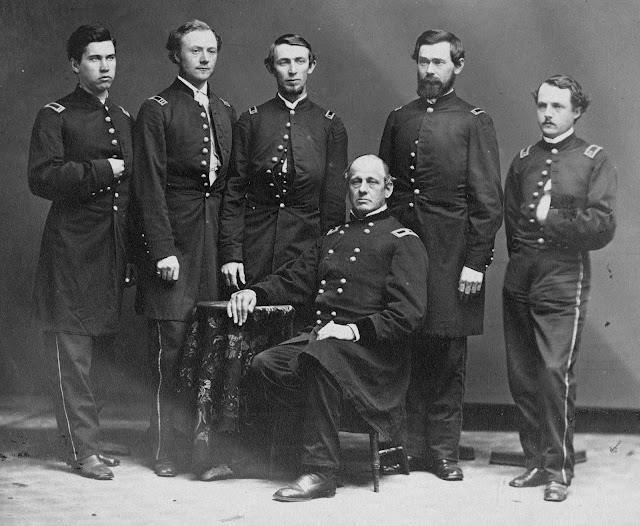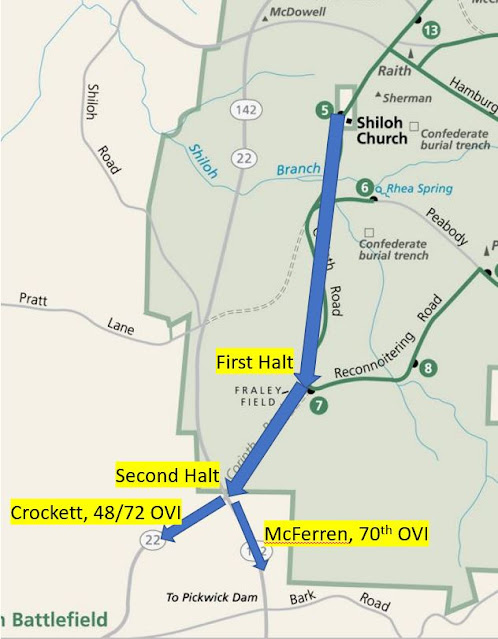Buckland's Picnic Excursion Before Shiloh
By early April 1862, the Federals encamped at Pittsburg Landing had settled into a comfortable routine of camp life. Drill twice per day with regular meals acclimated the new troops comprising Colonel Ralph Buckland’s brigade to the army life. Writing from camp on April 1st, Private John M. Lemmon of the 72nd Ohio observed that “quiet reigns with this portion of the army though we know not at what time we may get the order to march. Old Sol begins to pour down his hottest rays upon us, making the shady side of the tent, tree, or the like the most bearable. The weather is quite spring-like but vegetation does not seem to come forward as rapidly as the warm weather would warrant. The trees have not yet put on their livery of green nor had the grass started but little. The Rebels are reported strengthening themselves at Corinth and have great numbers. They doubtless want to play their old game on us and keep us back by reporting great numbers on their own side.”
Colonel Buckland decided on April
3rd that he needed to break the routine. “A detachment of the 5th
Ohio Cavalry was sent out to the front each morning, returning in the evening
to report that they had been out 20 or 30 miles and could find no Rebels in our
front,” remembered Thomas Connelly of the 70th Ohio. “Colonel Buckland
thought it would be beneficial to the health of our boys to enjoy some suitable
exercise other than regular army duties and requested General Sherman to allow
his to take his brigade out on a kind of picnic excursion.” Buckland’s “picnic
excursion” had a more serious military purpose. “General Sherman ordered me to
take my brigade to the front on the Corinth Road four or five miles, send out
scouting parties, and see what I could discover, but cautioned me not to be
drawn into a fight with any considerable force of the enemy,” Buckland later
remembered.
Buckland’s command consisted of
three Ohio regiments, all new: the 48th Ohio, 70th Ohio,
and Buckland’s own 72nd Ohio. The troops had been armed at Paducah
less than a month before and had been in camp at Pittsburg Landing
for roughly three weeks. Shortly after breakfast, Buckland ordered the command
into column with the 70th Ohio in the lead, followed by the 72nd
Ohio with the 48th Ohio in the rear. They were all big regiments,
the brigade taking into the field more than 2,000 muskets. The men moved out in
light marching order with “one day’s rations in our haversacks and without
baggage,” Sergeant William J. Srofe of the 48th Ohio recalled.
Upon Buckland’s command, the
column marched south on the Corinth road for about three miles when the first
halt was called. At this point, Colonel Buckland ordered out Company A of both
the 70th and 72nd Ohio to deploy ahead of the column as
skirmishers. The march resumed without incident for another two miles when the
brigade came to a fork in the road. “I marched my brigade to the forks of the
road about five miles from our line where I halted and formed the brigade in
line between the two roads facing towards Corinth,” Colonel Buckland later
wrote. “Both roads, as I understood, led to Monterey, about two miles farther
towards Corinth. I then sent two companies of the 70th Ohio under
Major James W. McFerren [70th Ohio] forward on the left hand and two
companies under Major Leroy Crockett [72nd Ohio] on the right-hand
road.”
It was no surprise to find Major
Crockett up front with the troops. The energetic officer had resigned his
commission with the 65th New York (1st U.S. Chasseurs) to
accept the position as major in the new 72nd Ohio and was a great
favorite with the troops. “Major Crockett had great capacity as a drill master
and as an officer to educate, drill, and fit his soldiers for the field,” John
Lemmon later noted. “It was he, largely, who drilled and trained the 72nd Ohio.
He went into the field with the regiment, was a young man who took great
delight in drilling the regiment and as a consequence, had that work mostly to
do.”
Crockett led forward Co. K of
the 48th Ohio and Co. B of the 72nd Ohio to take over the
skirmish line and marched off down the right-hand road towards Monterey. “Our
boys all appeared pleased to have the honor,” Srofe continued. “We marched
about two miles in advance of the brigade when we halted at a small creek and
filled our canteens with fresh water. We numbered about 125 men in all under
the command of Major James S. Wise of the 48th and Major Leroy
Crockett of the 72nd Ohio. The two majors appeared to be very brave for they
rode 200-300 yards in advance all the time.”
 |
| Sergeant William J. Srofe, Co. K, 48th O.V.I. (Griff's Spared & Shared) |
“They halted at a house in the
center of a field when they saw about 30 Rebel cavalry in a covering of woods,”
Srofe continued. “Major Wise rode back to the brigade for another detachment
but Major Crockett remained at the house close to the woman and children to keep
the Rebels from firing at him, but as they saw us marching up, they fired on
him without respect to the woman and children. But we were there in time and
opened fire on them, their balls whistling over us but too high to do any harm.
The Major ordered us not to waste our ammunition but to fire when they saw an
object. The Rebels had run and cracky how they ran: I had to laugh after they
had fled to think how they spurred their horses.”
Major McFerren’s detachment also
ran into Confederate videttes on the left-hand road. “Major John W. McFerren of
the 70th Ohio with seven men was sent further out on the road as pickets and
they had not advanced very far before they were challenged. ‘Halt! Who comes
there!’ To which the Major replied, ‘It is the advance guard of the Grand Army
of the United States.’ To which the challenger replied, ‘The hell you say!’ at
the same time sending a volley of cold lead toward the Major and his men who
retreated back to brigade lines with greater speed than when they advanced,”
recalled Thomas Connelly of the 70th Ohio.
“Major Crockett soon after sent word to me
that there was a large force of cavalry in sight and that he would need
reinforcements,” Colonel Buckland wrote. “In accordance with my instructions
not to be drawn into a fight, I ordered Majors Crockett and McFerren to return
to the brigade. While there, several of the soldiers reported to me that they
distinctly heard the long roll in the direction of Monterey. I did not. Soon
after the scouting companies returned, we commenced our march back to camp when
we arrived a little before dark and I reported immediately to Gen. Sherman.
 |
| Second Lieutenant John J. Geer, Co. K, 48th O.V.I. |
Lieutenant John J. Geer of the
48th Ohio was serving on Buckland’s staff and Buckland ordered him out
to retrieve the skirmishers before they got into more serious trouble. “When I
rode to top of the hill, I could see the enemy about 200 yards distant,” he wrote.
“The lieutenant of the 72nd was holding his men in readiness and
just as I reached them, they arose and opened fire, at which the Rebels
retreated to the right evidently intending to flank us. But this was an
unfortunate movement for them as they had not proceeded far when they
encountered Major Crockett of the 72nd with 200 men by whom they
were repulsed with heavy loss. By this time, I had come up with the brigade.
Buckland dispatched me immediately to order Crockett to fall back but to
continue fighting while retreating.”
“As I proceeded on my way to
Crockett (who indeed was a brave and daring officer) I met a lady of advanced
age in great distress. She was wringing her hands and crying, ‘Oh my son! Oh,
my son! Save me and my poor son!’ I rode forward to Crockett and found that he
had repulsed the enemy and was falling back in order. Being alone and in
advance of the retreating companies, I again encountered the old lady on the
same spot where I first saw her. Inquiring the cause of her grief, I learned
that the Rebels had been at her house representing themselves as Union men and
that she had expressed herself to them with disguise or reserve. They had
thereupon seized her son, tied him to a horse, and bore him away intending to
press him into their service,” Geer remembered.
 |
| Private Samuel Shutts Co. B, 72nd O.V.I. Killed in action April 6, 1862 |
“We then fell back to the brow
of the hill,” Srofe continued. “To keep them from outflanking us, we deployed
taking intervals of three paces. We sat down all watching for the Rebels but
Major Wise came up in due time with another detachment, so the Rebels concluded
they had better let us alone. We did not follow them for it was no use- we
being infantry and they cavalry, nor did we go to see if we killed any of them.
In about ten minutes after the firing, the long roll was heard to beat over in
the Rebel camp. Our company and Co. B of the 72nd acted as the rear
guards being 400 yards in the rear of the brigade and deployed in groups of
four, taking intervals of 20 paces. We got back to camp about 6 o’clock in the
evening making about 14 miles we marched in seven hours. The boys all took it
very coolly as much as could be expected.”
The men of Buckland’s brigade
would have another scrap with the Confederate cavalry the following afternoon,
and this time both Major Crockett and Lieutenant Geer would get captured.
Sources:
Masters, Daniel A., editor. Sherman’s Praetorian Guard: Civil War Letters of John McIntyre Lemmon, 72nd Ohio Volunteer Infantry. Perrysburg: Columbian Arsenal Press, 2017, pgs. 33-34
Lemmon, John M. “Leroy Crockett,” Ohio Soldier, October 8, 1887, pgs. 115-116
Connelly, Thomas W. History of the 70th Regiment, O.V.V.I., From Its Organization to its Mustering Out. Cincinnati: Peak Bros., 1902, pgs. 19-20
Letter from Sergeant William Jasper Srofe, Co. K, 48th Ohio Volunteer Infantry, dated April 4, 1862, Griff’s Spared & Shared website
Geer, John J. Beyond the Lines: A Yankee Prisoner Loose in
Dixie. Philadelphia: J.W. Daughaday, 1863, pgs. 23-25












Comments
Post a Comment